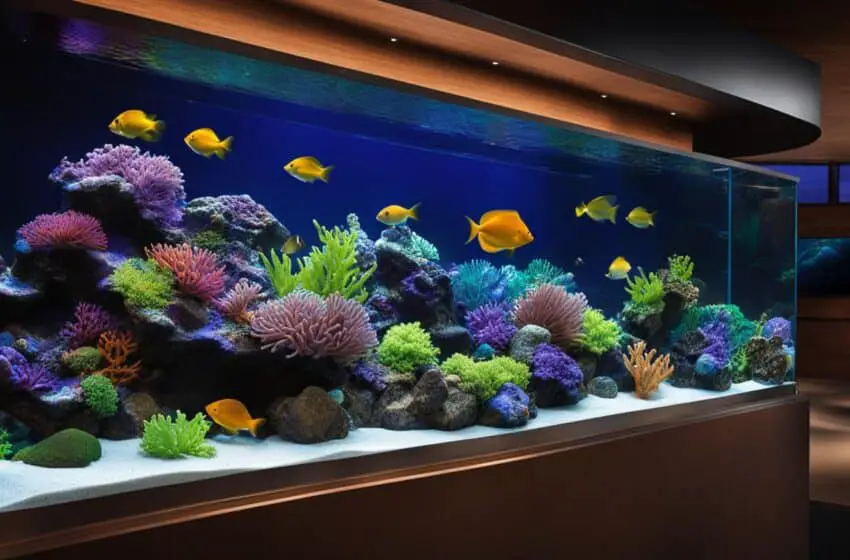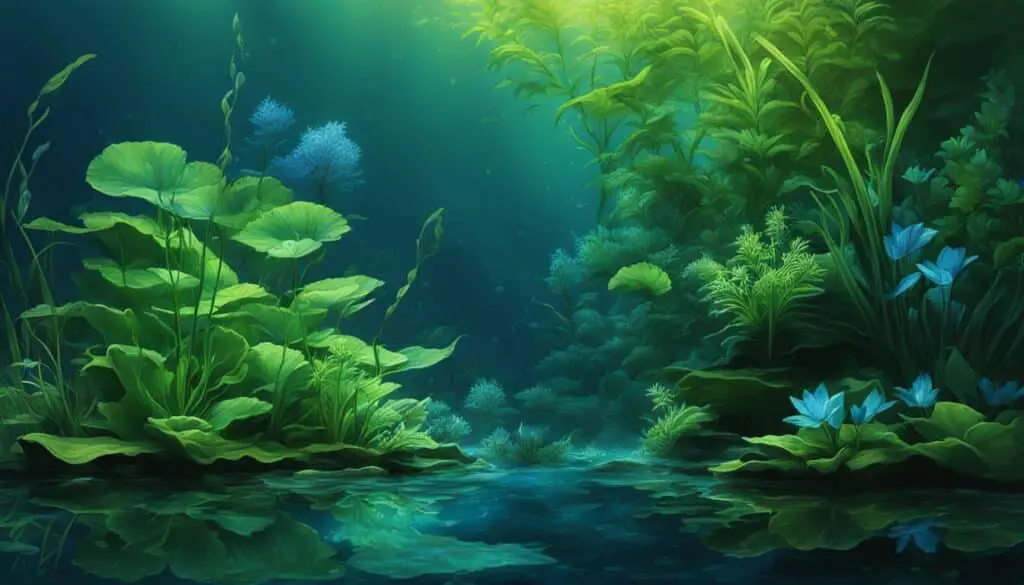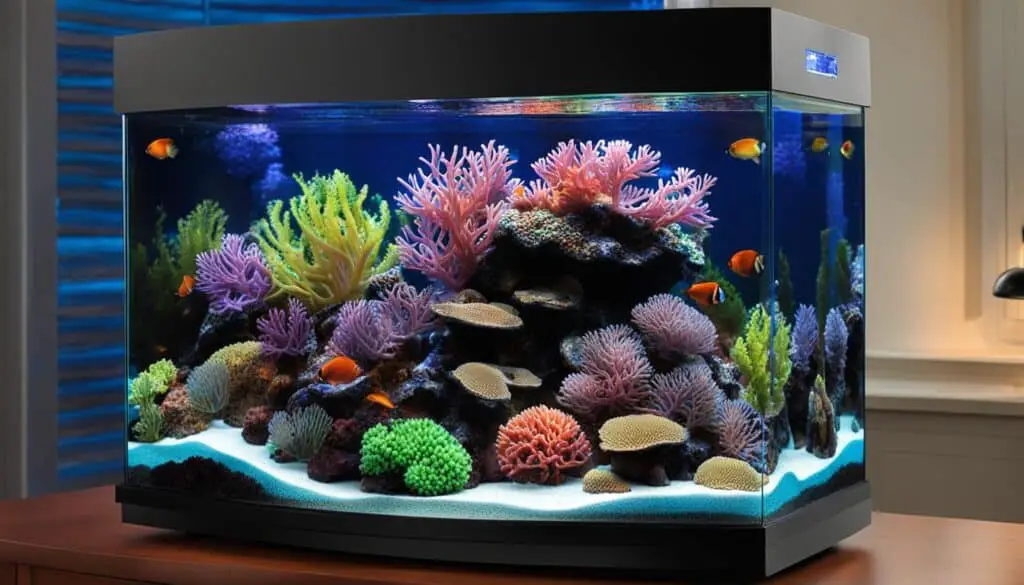DIY Lighting Upgrades for Your Saltwater Aquarium

In this guide, I will walk you through the steps of DIY lighting upgrades for your saltwater aquarium, allowing you to enhance the beauty of your marine habitat. Upgrading your saltwater aquarium lighting is essential for the health and vitality of your marine life, particularly in saltwater reef tanks. LED lighting has become the preferred choice for saltwater aquariums due to its cost-effectiveness, safety, and versatility. By following these steps, you can upgrade your tank’s lighting to LED, which provides better control, longevity, and energy efficiency compared to traditional lighting options.
To begin the DIY lighting upgrade process, it is important to understand the benefits of LED lights for aquariums. LED lights offer advantages such as consistent temperature control, adjustable lighting intensity, energy efficiency, and longer lifespan. These lights can be customized to mimic the natural lighting conditions found in the ocean, providing optimal growth and coloration for corals and other marine life.
When choosing the right light spectrum for your aquarium plants, it is essential to consider their specific lighting needs. Aquatic plants require specific light spectrums to promote photosynthesis and overall growth. A combination of cool white and neutral white LED bulbs with varying Kelvin temperatures can provide the ideal light spectrum for optimal plant growth in your aquarium.
Constructing homemade LED lights for your aquarium can be a cost-effective and customizable solution. By using LED strip kits, black duct tape, Saran Wrap, cardboard, speaker wire, and adhesive liquid, you can build your own LED lights that meet your specific aquarium needs. This DIY approach allows you to have full control over the lighting setup, ensuring the best conditions for your marine habitat.
Setting the duration of lighting in your aquarium plays a crucial role in the wellbeing of your aquatic life. It is important to provide a day and night simulation, with a maximum of 16 hours of daylight for fish and invertebrates to avoid stress and promote natural behaviors. For planted aquariums, a lighting duration of 10 to 12 hours is ideal to support photosynthesis and plant growth. Consistency in the lighting schedule is key to maintaining a stable environment for your marine life.
By following this DIY lighting upgrade guide, you can enhance the beauty and health of your saltwater aquarium. LED lighting provides numerous benefits, including cost-effectiveness, energy efficiency, and customization options. Invest in LED lighting upgrades and transform your saltwater reef tank into a stunning marine habitat.
Key Takeaways:
- Upgrading your saltwater aquarium lighting to LED offers cost-effectiveness, energy efficiency, and customization options.
- LED lights provide optimal lighting conditions for both plant growth and the wellbeing of marine life.
- Understanding the benefits and light spectrum requirements for aquarium plants is crucial for their overall growth and health.
- Constructing homemade LED lights allows you to customize the lighting setup to meet your specific aquarium needs.
- The duration of lighting in your aquarium should be tailored to the needs of your fish, invertebrates, and plants, promoting a stable environment.
Understanding LED Lights for Aquariums
LED lights are revolutionizing the world of aquarium lighting, bringing numerous benefits to both freshwater and saltwater setups, especially saltwater reef tanks. With their advanced technology and customizable features, LED lights offer a superior lighting solution for aquarium enthusiasts. Let’s explore the key advantages of LED lights and why they are the preferred choice for aquariums.
Benefits of LED Lights for Aquariums
1. Adjustable Lighting Intensity: LED lights allow you to fine-tune the lighting intensity according to the specific needs of your aquatic ecosystem. This adjustable feature is particularly beneficial for saltwater reef tanks, where corals require different light intensities for optimal growth and coloration.
2. Energy Efficiency: LED lights are highly energy-efficient, consuming significantly less power compared to traditional lighting options. This not only translates into cost savings but also reduces the environmental impact of your aquarium setup.
3. Longer Lifespan: LED lights boast a substantially longer lifespan compared to other lighting alternatives. With an average lifespan of 50,000 to 100,000 hours, LED lights can serve you for several years, minimizing the need for frequent replacements.
4. Consistent Temperature Control: LED lights generate minimal heat, making it easier to maintain a stable temperature within your aquarium. This is crucial for the comfort and wellbeing of your aquatic inhabitants, as sudden temperature fluctuations can be harmful.
5. Customizable Lighting Effects: LED lights offer a wide range of color options, allowing you to create captivating lighting effects for your aquarium. Whether you want to mimic natural daylight or enhance the vibrancy of your corals, LED lights can be tailored to your desired aesthetic.
How LED Lights Enhance Saltwater Reef Tanks
Saltwater reef tanks require specific lighting conditions to support the growth and vitality of corals and other marine life. LED lights excel in providing the necessary lighting spectrum and intensity for reef tanks. By replicating the natural lighting conditions of coral reefs, LED lights enable corals to thrive, promoting their health, growth, and vibrant coloration.
LED lights allow you to simulate sunrise and sunset cycles, creating a more natural environment for your saltwater reef tank. This not only enhances the visual appeal of your aquarium but also helps regulate the biological rhythms of your marine inhabitants, promoting their overall wellbeing.
Furthermore, LED lights are suitable for both shallow and deep reef tanks, as they can penetrate the water column more effectively. This ensures that light reaches the depths of the aquarium, providing consistent illumination throughout and supporting the photosynthetic needs of corals across various tank configurations.
Choosing the Right Light Spectrum for Aquarium Plants
Aquatic plants rely on specific light spectrums to drive the process of photosynthesis, where they convert light energy into chemical energy. This crucial process fuels their growth and overall health. When it comes to selecting the right lighting for your aquarium plants, understanding the importance of different light spectrums is key.
Blue, red, and yellow spectrums play a vital role in promoting plant growth by facilitating chlorophyll production, which is essential for photosynthesis. By providing your aquarium plants with the ideal light spectrum, you can ensure optimal growth and vibrant colors in your aquatic environment.
To achieve the right light spectrum, LED bulbs are an excellent choice. LED bulbs offer versatility and energy efficiency, making them well-suited for aquarium lighting. A combination of cool white and neutral white LED bulbs with varying Kelvin temperatures (around 6000K) can provide the perfect light spectrum for your aquarium plants.
When selecting LED bulbs for your aquarium, it’s crucial to consider the specific lighting needs of your aquatic plants. Different plants have varying requirements, and tailoring the light spectrum accordingly is essential for their well-being.
Benefits of LED Bulbs for Aquarium Plants
- Energy efficient: LED bulbs consume less electricity compared to traditional lighting options, reducing energy costs and environmental impact.
- Long lifespan: LED bulbs have a significantly longer lifespan, saving you money on replacements and maintenance.
- Customizable light spectrum: LED bulbs allow you to fine-tune the light spectrum to meet the specific needs of your aquarium plants.
- Reduced heat transfer: LED bulbs emit less heat, preventing excessive temperature increases in your aquarium.
By choosing the right light spectrum for your aquarium plants and utilizing LED bulbs, you can provide the optimal conditions for photosynthesis, leading to healthier and more vibrant aquatic plants.
| Advantages of LED Bulbs for Aquarium Plants | Benefits |
|---|---|
| Energy Efficiency | Reduced electricity consumption and cost savings |
| Long Lifespan | Less frequent bulb replacements and maintenance |
| Customizable Light Spectrum | Tailor the lighting to meet specific plant requirements |
| Minimal Heat Transfer | Avoid excessive temperature increases in the aquarium |
Investing in LED bulbs with the right light spectrum is a crucial step towards creating a thriving aquatic ecosystem in your aquarium. With their energy efficiency and customizable lighting options, LED bulbs provide an ideal solution for promoting the growth and vitality of your aquarium plants.

Constructing Homemade LED Lights for Your Aquarium
Building your own LED lights for your aquarium can be a cost-effective and customizable solution. With a few materials and some simple construction steps, you can create a lighting setup that meets your specific aquarium needs. Follow this step-by-step guide to construct DIY LED lights for your aquarium.
Gather the Materials
- LED strip kits
- Black duct tape
- Saran Wrap
- Cardboard
- Speaker wire
- Adhesive liquid
Measure and Cut
Measure the dimensions of your aquarium and cut the cardboard to fit as a base for your LED lights. Ensure you leave space for the LED strips to be attached securely.
Assemble the LED Strips
Solder the LED strips together according to the desired length required to cover your aquarium. Be sure to follow the manufacturer’s instructions for proper soldering techniques.
Attach the LED Strips
Use adhesive liquid or black duct tape to secure the LED strips onto the cardboard base. Ensure the LED strips are evenly spaced for uniform lighting.
Protect the LEDs
Cover the LED strips with Saran Wrap to protect them from moisture, as aquarium environments can be damp. This will help prolong the lifespan of your homemade LED lights.
Connect the Wiring
Strip the ends of the speaker wire and connect them to the respective positive and negative terminals of the LED strips. This will provide the power needed to illuminate the LEDs.
Test and Adjust
Connect the wiring to a power source and use a remote control (if applicable) to test the brightness levels of your homemade LED lights. Adjust the lighting as desired to achieve the desired ambiance for your aquarium.
With these simple steps, you can construct your own LED lights for your aquarium, allowing you to customize the lighting to suit the unique needs of your aquatic environment.
| Materials | Description |
|---|---|
| LED strip kits | Flexible LED strips that emit light |
| Black duct tape | Adhesive tape for securing LED strips |
| Saran Wrap | Transparent film for protecting the LEDs from moisture |
| Cardboard | A sturdy base for attaching the LED strips |
| Speaker wire | Conducting wire for connecting LEDs to power source |
| Adhesive liquid | Strong adhesive for securing LED strips |
Setting the Duration of Lighting in an Aquarium
The duration of lighting in an aquarium plays a crucial role in the overall health and well-being of the aquatic life it houses. Whether you have a planted aquarium or one with fish and invertebrates, understanding the ideal lighting duration is essential for promoting optimal plant growth and reducing stress for the inhabitants. In this section, I will guide you on how to determine the appropriate lighting duration for your aquarium, ensuring a stable and thriving environment for your fish, plants, and other aquatic organisms.
For fish and invertebrates, it is important to provide a day and night simulation that mimics their natural habitat. This helps them maintain their natural behaviors and reduces stress levels. Typically, a maximum of 16 hours of daylight is recommended, followed by 8 hours of darkness to replicate a natural day-night cycle.
“Providing the right lighting duration is crucial for promoting optimal plant growth in aquariums.”
On the other hand, if you have a planted aquarium, the lighting duration should be adjusted to support photosynthesis and promote healthy plant growth. Plants require a consistent duration of light exposure to carry out photosynthesis effectively. Aim for a lighting duration of 10 to 12 hours per day to provide sufficient energy for the plants and allow them to flourish.
For aquariums without live plants, such as those focused primarily on fish wellbeing, a lighting duration of 8 to 10 hours is generally suitable. This provides adequate lighting while allowing for periods of darkness to mimic natural day-night cycles. Consistency is key, as it helps maintain a stable environment for the fish and promotes their well-being.
To summarize, the duration of lighting in your aquarium should be tailored to the specific needs of its inhabitants. Whether you have fish, plants, or a combination of both, it is important to strike a balance between providing enough light for growth and allowing for natural rest periods. By following the recommended guidelines mentioned above, you can ensure the optimal lighting duration for your aquarium, promoting plant growth and the overall well-being of your fish.

Image: An aquarium with well-adjusted lighting duration promotes plant growth and fish well-being.
Conclusion
Investing in DIY LED lighting upgrades for your saltwater aquarium is a wise decision that can bring numerous benefits to your marine habitat. Not only are LED lights more cost-effective and energy-efficient compared to traditional lighting options, but they also provide optimal lighting conditions for both plant growth and the overall well-being of your marine life.
By following the steps outlined in this saltwater aquarium lighting guide, you can create a tailored lighting system that enhances the beauty and health of your marine habitat. The versatility of LED lights allows for customization, giving you the flexibility to adjust the lighting intensity and color spectrum to mimic natural lighting conditions.
With LED lighting, you can promote optimal plant growth, vibrant coloration in corals, and provide a comfortable environment for your fish and invertebrates. LED lights are known for their longevity, ensuring that your marine habitat is well-lit for years to come without the hassle of frequent replacement.
Upgrade your saltwater aquarium lighting with DIY LED lighting upgrades today and enjoy the benefits of cost-effectiveness, energy efficiency, and customization options. Transform your aquarium into a stunning and thriving marine masterpiece with LED lighting.
FAQ
Why are LED lights the preferred choice for saltwater aquariums?
LED lights are preferred for saltwater aquariums due to their cost-effectiveness, safety, and versatility. They provide better control, longevity, and energy efficiency compared to traditional lighting options.
What benefits do LED lights offer for aquariums?
LED lights offer advantages such as consistent temperature control, adjustable lighting intensity, energy efficiency, and longer lifespan compared to traditional lighting options. They can be customized to mimic natural lighting conditions for optimal growth and coloration of corals and marine life.
What kind of light spectrum should I choose for my aquarium plants?
Aquatic plants require specific light spectrums to promote photosynthesis and growth. A combination of cool white and neutral white LED bulbs with varying Kelvin temperatures can provide the ideal light spectrum for optimal plant growth in your aquarium.
How can I construct homemade LED lights for my aquarium?
To construct homemade LED lights, you will need materials such as LED strip kits, black duct tape, Saran Wrap, cardboard, speaker wire, and adhesive liquid. The process involves measuring, cutting, soldering, and assembling the LED strips onto cardboard structures. The lights can be tested and adjusted for brightness using a remote control.
How long should I keep the lights on in my aquarium?
The duration of lighting in an aquarium depends on the needs of the aquatic life within it. For fish and invertebrates, a maximum of 16 hours of daylight is recommended to avoid stress. For planted aquariums, 10 to 12 hours of lighting is ideal to support photosynthesis and plant growth. Non-planted aquariums can benefit from 8 to 10 hours of lighting to support fish wellbeing. Consistency in the lighting schedule is important for maintaining a stable environment.



